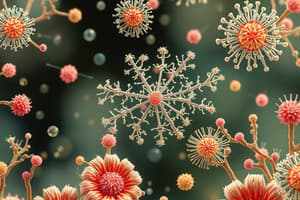Podcast
Questions and Answers
What is microbiology?
What is microbiology?
The study of organisms that are so small they cannot be seen with the naked eye.
Which of the following are categories of microorganisms?
Which of the following are categories of microorganisms?
- Acellular Infectious Agents
- Cellular Microorganisms
- Both A and B (correct)
- None of the above
Bacteriology is the study of ______.
Bacteriology is the study of ______.
bacteria
Match the following scientists with their contributions to microbiology:
Match the following scientists with their contributions to microbiology:
Joseph Lister is known as the Father of Antiseptic Surgery.
Joseph Lister is known as the Father of Antiseptic Surgery.
What did Anton van Leeuwenhoek call the microorganisms he observed?
What did Anton van Leeuwenhoek call the microorganisms he observed?
Who is known as the Father of Immunology?
Who is known as the Father of Immunology?
What is the primary use of Salvarsan discovered by Paul Ehrlich?
What is the primary use of Salvarsan discovered by Paul Ehrlich?
Which process is associated with Louis Pasteur?
Which process is associated with Louis Pasteur?
What characterizes a bacterium with a glycocalyx that is loosely attached to the cell wall?
What characterizes a bacterium with a glycocalyx that is loosely attached to the cell wall?
Which type of flagellar arrangement describes a bacterium with a single flagellum?
Which type of flagellar arrangement describes a bacterium with a single flagellum?
How does the structure of axial filaments differ from regular flagella?
How does the structure of axial filaments differ from regular flagella?
What is the primary composition of a Gram-positive cell wall?
What is the primary composition of a Gram-positive cell wall?
Which statement about the bacterial cell wall is accurate?
Which statement about the bacterial cell wall is accurate?
Which scientist is credited with the classification of bacteria into four distinct groups based on their shape?
Which scientist is credited with the classification of bacteria into four distinct groups based on their shape?
Which term refers to the process developed by Louis Pasteur that is aimed at food preservation?
Which term refers to the process developed by Louis Pasteur that is aimed at food preservation?
Who discovered the first effective treatment for syphilis, known as Salvarsan?
Who discovered the first effective treatment for syphilis, known as Salvarsan?
Which of the following individuals is recognized for establishing Koch's postulates?
Which of the following individuals is recognized for establishing Koch's postulates?
What is the primary significance of Anton van Leeuwenhoek's work in microscopy?
What is the primary significance of Anton van Leeuwenhoek's work in microscopy?
Which of the following best describes the contributions of Joseph Lister to medicine?
Which of the following best describes the contributions of Joseph Lister to medicine?
What does the term 'abiogenesis' refer to, which Louis Pasteur disproved?
What does the term 'abiogenesis' refer to, which Louis Pasteur disproved?
Which scientist's discovery of penicillin significantly advanced the treatment of bacterial infections?
Which scientist's discovery of penicillin significantly advanced the treatment of bacterial infections?
What significant event in the medical field did Howard Florey and Ernst Chain contribute to?
What significant event in the medical field did Howard Florey and Ernst Chain contribute to?
What is the primary component of the cell walls of eubacteria?
What is the primary component of the cell walls of eubacteria?
How do prokaryotic cells fundamentally differ from eukaryotic cells?
How do prokaryotic cells fundamentally differ from eukaryotic cells?
What role did Ignaz Semmelweis play in the improvement of medical practices?
What role did Ignaz Semmelweis play in the improvement of medical practices?
Which of the following groups of microorganisms is known to have no medical importance?
Which of the following groups of microorganisms is known to have no medical importance?
What type of locomotion is primarily used by protozoa?
What type of locomotion is primarily used by protozoa?
What distinguishes true fungi from plants?
What distinguishes true fungi from plants?
Which type of bacteria reproduces through binary fission?
Which type of bacteria reproduces through binary fission?
What is the primary function of teichoic acids in bacterial cells?
What is the primary function of teichoic acids in bacterial cells?
Which component of the Gram-negative cell wall contributes to its impermeability to antibacterial agents?
Which component of the Gram-negative cell wall contributes to its impermeability to antibacterial agents?
What is the significance of Lipid A in the Gram-negative outer cell envelope?
What is the significance of Lipid A in the Gram-negative outer cell envelope?
What composes the ribosomes found in bacterial cells?
What composes the ribosomes found in bacterial cells?
Which of the following is a characteristic of plasmids in bacterial cells?
Which of the following is a characteristic of plasmids in bacterial cells?
What role do inclusions play in bacterial cells?
What role do inclusions play in bacterial cells?
What is the water content percentage of the cytoplasm in bacterial cells?
What is the water content percentage of the cytoplasm in bacterial cells?
What distinguishes wall teichoic acid from lipoteichoic acid?
What distinguishes wall teichoic acid from lipoteichoic acid?
Which statement correctly describes algae?
Which statement correctly describes algae?
What distinguishes prions from viruses?
What distinguishes prions from viruses?
Which of the following is a characteristic unique to helminths?
Which of the following is a characteristic unique to helminths?
Which type of bacteria is classified as cocci?
Which type of bacteria is classified as cocci?
What is the primary function of the glycocalyx in bacteria?
What is the primary function of the glycocalyx in bacteria?
Which of the following best defines the structure of a virus?
Which of the following best defines the structure of a virus?
Which statement about roundworms is correct?
Which statement about roundworms is correct?
Which of the following diseases is caused by prions?
Which of the following diseases is caused by prions?
Flashcards are hidden until you start studying
Study Notes
What is Microbiology?
- Derived from Greek: "mikros" (small), "bios" (life), "logia" (study/science)
- Focuses on microorganisms, which are too small for naked-eye visibility
- Microorganisms divided into:
- Acellular Infectious Agents:
- Prions
- Viruses
- Cellular Microorganisms:
- Prokaryotes:
- Archaea
- Bacteria
- Eukaryotes:
- Algae
- Fungi
- Protozoa
- Prokaryotes:
- Acellular Infectious Agents:
Divisions of Microbiology
- Bacteriology: Study of bacteria
- Virology: Study of viruses
- Mycology: Study of fungi
- Parasitology: Study of protozoa and parasitic worms
- Phycology: Study of algae
- Immunology: Study of the immune system and responses
Importance of Studying Microbiology
- Normal Flora: Approximately 1000 species in the human body; can cause disease in immunocompromised individuals
- Biotechnology: Critical for food production, pharmaceuticals, and genetics
- Antimicrobial Agents: Source of important medications from bacteria and fungi
- Decomposition: Essential role in nutrient recycling in ecosystems
- Awareness of Risks: Informs on disease resurgence, biological warfare threats, and antibiotic resistance
Nomenclature
- System of naming established by Carolus Linnaeus in 1735
- Latin used for scientific names, which consist of two parts: Genus and species
- Names can describe organisms, honor researchers, identify habitats, or signify uses
History of Microbiology
- Robert Hooke:
- English scientist, considered the Father of Cytology
- Discovered cells, termed them "little boxes," and authored Micrographia
- Proposed Cell Theory: all living things are composed of cells
- Anton van Leeuwenhoek:
- Dutch merchant; first to observe live microorganisms, termed animalcules
- Known as the Father of Microscopy
- Louis Pasteur:
- Disproved Spontaneous Generation; established biogenesis
- Developed pasteurization and fermentation processes
- Ferdinand Julius Cohn:
- German biologist; classified bacteria into four groups: cocci, bacilli, spirochetes, spirilla
- Highlighted microbial diversity
- Robert Koch:
- German physician; established Koch's postulates linking specific organisms to specific diseases
- Recognized as the Father of Microbiological Techniques
- Edward Jenner:
- Developed first vaccine for smallpox; known as the Father of Immunology
- Joseph Lister:
- Father of Antiseptic Surgery; introduced carbolic acid techniques for infection prevention
- Founded principles of modern infection control
- Paul Ehrlich:
- Father of Chemotherapy; discovered Salvarsan for syphilis treatment
- Known for the concept of "magic bullet" in disease treatment
- Alexander Fleming:
- Discovered penicillin from Penicillium notatum
- Pioneered the antibiotic era beginning in the 1940s
- Critically improved treatment for bacterial infections
Conclusion
- Microbiology encompasses a wide range of studies essential for medical, ecological, and technological advancements, linking historical figures to modern practices and understanding of microorganisms.
Historical Figures in Microbiology
- Hooke's Micrographia (1665) provided the first descriptions of plant cells.
- Anton van Leeuwenhoek, a Dutch merchant, invented the single lens microscope and first observed live microorganisms, dubbing them animalcules; known as the Father of Microscopy and Microbiology.
- Louis Pasteur disproved spontaneous generation, establishing that microbes arise only from existing microbes (biogenesis) and developed pasteurization for food preservation.
- Ferdinand Julius Cohn classified bacteria into four groups: cocci (spherical), bacilli (short rods), spirilla (spirals), and spirochetes (thread-like).
- Robert Koch established Koch's postulates, demonstrating a specific organism's role in causing specific diseases; recognized as the Father of Microbiological Techniques.
- Edward Jenner created the first smallpox vaccine, earning the title Father of Immunology.
- Joseph Lister pioneered antiseptic surgery, introducing carbolic acid methods to prevent infections during surgeries, forming the basis of modern infection control.
- Paul Ehrlich discovered Salvarsan for syphilis treatment, considered the first blockbuster drug, thus earning the title Father of Chemotherapy.
- Alexander Fleming discovered penicillin from Penicillium notatum, launching the antibiotic era in the 1940s to treat various infections.
- Ignaz Semmelweis advocated for handwashing to prevent infection in medical settings, recognized as the Father of Infection Control.
Microbial Cell Types
- Microorganisms are categorized into prokaryotes (lacking a nucleus) and eukaryotes (containing membrane-bound organelles).
- Viruses are acellular and do not fit into prokaryotic or eukaryotic classifications.
Classification of Microorganisms
- Eubacteria:
- Important in medicine, featuring peptidoglycan in cell walls; reproduce via binary fission; some possess flagella for movement.
- Archaea:
- Non-medical significance, found in extreme environments (methanogens, extreme halophiles, thermophiles); not known to infect humans.
- Fungi:
- Can be unicellular or multicellular; cell walls contain chitin; includes molds and yeasts; causes diseases classified by infection location.
- Protozoa:
- Unicellular eukaryotic organisms using pseudopods, flagella, or cilia for movement; reproduce asexually or sexually; can act as free entities or parasites.
- Algae:
- Photosynthetic eukaryotes with cellulose in cell walls; exist in various habitats; beneficial for food and nutrient sources but not harmful to humans.
- Helminths:
- Parasitic eukaryotic worms, further categorized into tapeworms, flukes, and roundworms.
- Viruses:
- Simple acellular agents, requiring host cellular machinery for reproduction; consist of nucleic acid core and protein coat (capsid).
- Prions:
- Infectious protein particles linked to fatal neurodegenerative diseases, but their precise mechanisms remain unclear.
Bacterial Structure and Function
- Bacterial shapes:
- Cocci (spherical), Bacilli (rod-shaped), Spiral (curved).
- Glycocalyx:
- A sticky outer layer for attachment and evasion of the immune response, categorized as capsules (organized) or slime layers (loose).
- Flagella:
- Motility structures classified by arrangements such as peritrichous (all over), monotrichous (single), and lophotrichous (tufts).
- Cell wall:
- Provides shape and protection; Gram-positive bacteria have thick peptidoglycan, while Gram-negative bacteria have a thin layer and an outer membrane containing lipopolysaccharides.
- Plasma membrane:
- Selective barrier for transport; contains enzymes for metabolic reactions.
- Cytoplasm:
- Composed of water, nutrients, ribosomes, and inclusions.
- Nucleoid:
- Contains bacterial DNA in a circular form, essential for cell function.
- Ribosomes:
- Sites for protein synthesis, targeted by many antibiotics.
- Plasmids:
- Independent genetic elements that can confer traits like antibiotic resistance and are used in genetic engineering.
Internal Features of Bacteria
- Inclusions serve as nutrient reservoirs, vital during scarcity.
Studying That Suits You
Use AI to generate personalized quizzes and flashcards to suit your learning preferences.




